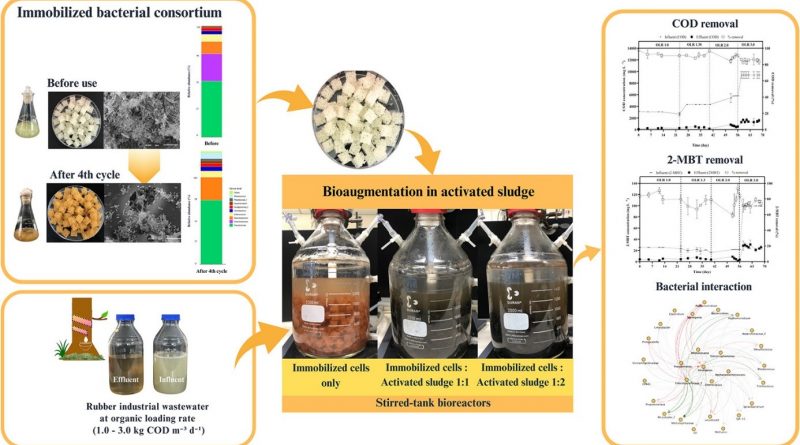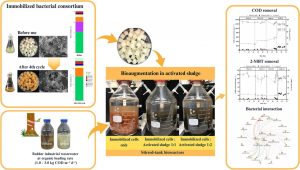Bioaugmentation of activated sludge with the immobilized 2-mercaptobenzothiazole-degrading bacterial consortium for rubber industrial wastewater treatment
การเติมกลุ่มเชื้อจุลินทรีย์ย่อยสลายสาร 2-mercaptobenzothiazole แบบยึดติดเพื่อใช้เพิ่มประสิทธิภาพระบบบำบัดน้ำเสียแบบตะกอนเร่งของโรงงานยาง
Effluent from the rubber industry contains 2-mercaptobenzothiazole (2-MBT) as the major persistent pollutant. To remove 2-MBT, this study investigated the bioaugmentation of activated sludge with a 2-MBT-degrading bacterial consortium, which was previously enriched from rubber wastewater sludge. The consortium was immobilized in a commercial porous carrier to increase its efficiency and stability. The 16S rRNA gene analysis showed that the dominant Pseudomonas spp. and Stenotrophomonas spp. were maintained when it was repeatedly used for 4 cycles in a minimal medium containing 300 mg L–1 2-MBT. For bioaugmentation, a stirred tank reactor containing the immobilized consortium and activated sludge at a 1:2 mass ratio was constructed and found to remove 88.2 % of 100 mg L-1 2-MBT from synthetic wastewater. When the rubber industrial wastewater was applied at an organic loading rate of 1.0–3.0 kg COD m-3 d-1, the reactor had 2-MBT and COD removal efficiencies of 70–79 % and 83–96 %, respectively. The reactors with either immobilized consortium or activated sludge alone had lower treatment efficiency. The bacterial community and its predicted functions corresponded to the activity of the added consortium and the operation of the reactor. Bioaugmentation should be applied to activated sludge for the treatment of rubber wastewater.
น้ำเสียจากโรงงานยางมีสาร 2-mercaptobenzothiazole (2-MBT) ซึ่งเป็นสารตกค้างยาวนานหลัก เพื่อที่จะกำจัดสาร 2-MBT งานวิจัยนี้ได้ศึกษาการเติมกลุ่มจุลินทรีย์แบบยึดติดเพื่อใช้เพิ่มประสิทธิภาพระบบบำบัดน้ำเสียแบบตะกอนเร่งของโรงงานยาง ซึ่งเป็นกลุ่มจุลินทรีย์ที่คัดแยกมาจากตะกอนน้ำเสียโรงงานยาง โดยใช้การยึดติดกับตัวพาแบบมีรูพรุนที่หาซื้อได้ในท้องตลาดเพื่อเพิ่มประสิทธิภาพการทำงานและความเสถียรในระบบของจุลินทรีย์ ผลการวิเคราะห์ยีน 16S rRNA แสดงว่าจุลินทรีย์หลัก Pseudomonas spp. และ Stenotrophomonas spp. สามารถคงอยู่ในการใช้งานกำจัด 2-MBT 300 mg/L ในอาหารเลี้ยงเชื้อที่ไม่มีสารอินทรีย์อื่นได้ถึง 4 ครั้ง การใช้ถังหมักแบบกวนผสมที่มีหัวเชื้อนี้และตะกอนระบบบำบัดแบบตะกอนเร่งในอัตราส่วนมวล 1:2 พบว่าสามารถกำจัดสาร 2-MBT ได้ 88.2 % จากความเข้มข้นตั้งต้น 100 mg/L ในน้ำเสียสังเคราะห์ และเมื่อนำน้ำเสียจากโรงงานยางมาผสมด้วยอัตราการเติมสารอินทรีย์ 1.0–3.0 kg COD/m3/d พบสาร 2-MBT และ COD ถูกกำจัดด้วยอัตราส่วน 70–79 % และ 83–96 % ตามลำดับ ซึ่งถังหมักที่ใช้แค่หัวเชื้อหรือตะกอนระบบบำบัดอย่างเดียวมีประสิทธิภาพการบำบัดที่น้อยกว่า และจากการประเมินการทำงานของจุลินทรีย์พบว่ามีความสอดคล้องกับความสามารถของการบำบัด ดังนั้นควรมีการเติมหัวเชื้อในระบบตะกอนเร่งในบำบัดน้ำเสียของโรงงานยาง
SDG หลัก 6: สร้างหลักประกันเรื่องน้ำและการสุขาภิบาลให้มีการจัดการอย่างยั่งยืน และมีสภาพพร้อมใช้สำหรับทุกคน
SDG ย่อย 6.3: ปรับปรุงคุณภาพน้ำ โดยการลดมลพิษ ขจัดการทิ้งขยะและลดการปล่อยสารเคมีอันตรายและวัสถุอันตราย ลดสัดส่วนน้ำเสียที่ไม่ผ่านกระบวนการลงครึ่งหนึ่ง และเพิ่มการนำกลับมาใช้ใหม่และการใช้ซ้ำที่ปลอดภัยอย่างยั่งยืนทั่วโลก ภายในปี 2573


